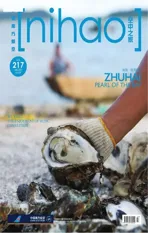Small City Of Great Wisdom
2017-07-20TextbyMadelineWengPhotosbyZengJianVCGTranslationbySoniaIllustrationbyNanFang
Text by Madeline Weng Photos by Zeng Jian & VCG Translation by Sonia Illustration by Nan Fang
Small City Of Great Wisdom
Text by Madeline Weng Photos by Zeng Jian & VCG Translation by Sonia Illustration by Nan Fang
The charisma of a city is often found among the backstreet alleyways. From the fi shermen working diligently on the beach, vigorous senior performers in crane costumes, and the therapeutic massage master treating patients with endogenous power, it is apparent that the people's wisdom and pragmatism is exactly the reserved wealth the city Zhuhai has cultivated for a millennium.

Qianwu Town, Doumen District, is located in the coastal sand land at the west of Zhuhai City. It boarders the South Sea and the climate is warm. In addition, there is a dense water network and the salinity of sea water is perfect, providing water composition and a natural food source for growing sea catfish.斗门区乾务镇地处珠海市西部的滨海大沙田地区,濒临南海,气候温润;加之水网交错,海水咸淡适宜,为泥鱼的生长提供了水质和天然的食物来源。
小城大智
一座城市的味道,往往存在于寻常巷陌中。从滩涂上辛勤劳作的捉鱼人,披着鹤衣神采奕奕的老艺人,以内力医病的推拿大师身上,不难捕捉到来自民间的智慧与低调的务实精神,这正是珠海这座城市孕育千年的无声财富。
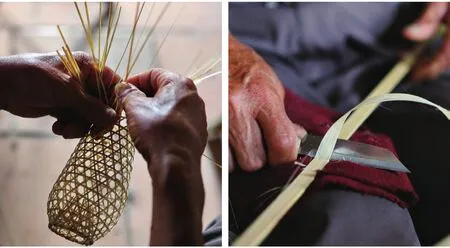
Making baskets: Cut and grind the bamboo. Bend the bamboo and cut in to slices of ten with a knife. Weave the slices to one bottomless, vase-shaped basket.编泥鱼笼的主要过程:削竹子,将其打磨光滑,随后施力弄弯,用利刀平均切割成十几条细长的竹条,编织成一只无底花瓶形状的篓子。
Fisheries in Fertile Land
Sixty-three-year-old Hushan fi sherman Huang Guofu witnessed the highs and lows of the custom of trapping sea catfi sh in Qianwu Town.
“In the mid-20th century, when trapping sea catfi sh reached its peak, the routine in every household was to catch fi sh very early in the morning and make baskets after returning home in the evening,”said Huang. “The baskets made of bamboo are thin and need to be replaced frequently. We didn't have electric light at the time, so we lit up oil lamp at night and the whole family made the baskets together. At three in the morning, we had to set out to catch fi sh and didn't return home until eight in the evening.”
Huang started learning how to make baskets from the older generation at the age of 14. As a beginner, he got cuts on his hands by the bamboo burrs, but he gradually mastered the craft. Now it takes only eight minutes for Huang to make a basket, three times faster than other villagers.
This vase-shaped fi sh-catching device is the fruit of Qianwu fi shermen's folk wisdom accumulated over three hundred years. The end with its larger opening has a one-way passage – once the sea catfi sh get in, there is no way out.
“Sea catfi sh are keen and will dig into the mud upon any noise. We will not be able to catch them with our bare hands. So we place baskets in area with signs of fi sh movement. As soon as we go away, the fi sh will come out boldly and swim into the baskets for us to harvest!” Huang Guofu spoke with a sly smile on his tanned face. Huang brings 200 baskets every time he goes trapping sea catfi sh, putting 100 baskets at each end of the beach and later collecting the baskets in sequential order.
Sea catfi sh grow to the largest between November and February Ð the best time for trapping sea catfi sh. The fi shermen invented a step-on plate to prevent their knees from sinking into the cold beach in winter. The plate creates a wider service area so the fi shermen are less likely to sink.
Nowadays, the beaches in Hushan Village have been turned to cropland and farms growing fi sh and shrimps. Only a small part of the beach is kept for trapping sea catfi sh. In 2010, this folk custom was selected to be on the list of the Intangible Cultural Heritage in China. It was remedially protected. Huang is invited to teach pupils to weave baskets every week, but he's not sure how long this tradition will last.
沃土渔情

Huang GuofuInheritor of Trapping Sea Catfish, National Intangible Cultural Heritage黄国富国家级非物质文化遗产“装泥鱼”传承人
63岁的虎山渔民黄国富见证了乾务镇“装泥鱼”习俗的高低潮。
上世纪中叶,“装泥鱼”最盛的时候,家家户户都得早起捕鱼,晚归编笼。黄国富说:“竹笼薄,需要经常更换。那时候没有电灯,我们晚上就点着煤油灯,全家一起编笼子。早上3点,我们又得出发捕鱼,忙到8点才能回家。”
黄国富14岁便开始和老一辈学编笼。初学时,他也会被竹刺划破手,渐渐地便熟练了。现在,黄国富编织一个泥鱼篓只需要8分钟左右的时间,比一般村民快三倍。
这只花瓶形状的“捕鱼神器”凝聚了乾务渔民三百多年来的民间智慧——笼子开口较大的一端设有一个单向通道,泥鱼一旦游入其中,便无从逃出。
“泥鱼很灵敏,一听到动静就会钻进泥里,用手抓不到。我们就在有鱼踪迹的地方放上鱼笼,等我们走开了,泥鱼就大胆地出来,游到笼子里等我们收!”说着,黄国富黝黑的脸上浮现出一抹狡黠的笑容。每次去“装泥鱼”,黄国富都会带上200只泥鱼笼,在滩涂区域的两边各安置好100只笼子,然后紧接着回过头按顺序收笼。
泥鱼最肥的季节通常是11月到2月,那时也是“装泥鱼”最好的时机。为了避免双膝陷入冬天冰冷的滩涂中,渔民们还发明了踩踏用的泥板,降低了站在滩涂上时的压强,不容易沉下去。
如今,虎山村里的滩涂已经被开发为田地和鱼虾养殖场,留给“装泥鱼”的滩涂只有小小一块。2010年,这项民间习俗被列入了国家非物质文化遗产名录,被予以抢救性的保护和传承。现在,黄国富受邀每周去小学教孩子们编鱼笼。“装泥鱼”究竟还能走多远,还是个未知数。
Crane Dance Sending Blessings


The custom of crane dance originated from an intriguing legend in Sanzao Town, Jinwan District. One day, a lion got into a fi ght with a crane. A whitehaired old man came to mediate, persuading them to bid New Year blessings to every house since it was the New Year time and people will give red envelopes in return. Therefore, the crane and the lion started to wish people Happy New Year together at people's doorstep.
Sanzao is the largest island among Wanshan Islands. The island is surrounded by a large area of mangroves, beaches, and wetland. Abundant food source and proper living conditions attract animals like cranes to dwell here. To the Sanzao people, cranes represent virtue and longevity and the crane dance is a beautiful blessing.
This folk dance has lasted for 700 years to date. Whenever it is the holiday, the lion and crane dance teams in Haicheng Village, Sanzao Town, go to every household to perform. Dozens of people walk in parade, beating gongs and drums along the way. A lion pays respect at the door, and the crane and another lion enter the house, bowing at each other and greeting the senior people.
A crane dancer has to wear a white crane costume that weighs 4 kg, lifting crane head with hands and making all sorts of moves to demonstrate crane elegance. Different from the lion dance,
the crane dance not only mimes a crane's acts of catching fi sh, fl ying and frolicking but also goes with melodious crane songs, accompanied by drums, gongs and cymbals. The sound is deep and festive. Moreover, the lyrics of crane songs are sophisticated, often working as entertainment and education. Therefore, the locals are used to having children follow the lessons taught by the crane songs.
As society changes, this folk art relying on oral transmission is on the edge of extinction. To save the crane dance, after retirement Chen Fuyan started documenting the crane dance; he recorded methods of making crane costumes and performance steps through photos and marginal notes. Starting in 2008, elementary schools in the village began to set up crane dance legacy classes, training students selected by Chen free of charge. Until this day Chen has nurtured more than a thousand young successors.


Moves of Crane Dance.鹤舞分解动作示意图。
鹤舞送福
三灶舞白鹤的习俗,缘起于金湾区三灶镇一个有趣的传说:有一天,一只狮子和鹤打起来了,一位白发老人前来劝架,说现在大过年的,它俩要是一起拜年,每家每户都会给红包。于是,仙鹤和狮子便来到了人家门前拜年。
三灶是万山群岛中的第一大岛,海岛周围有大面积的红树林、滩涂和湿地,丰富的食物和适宜的环境常吸引白鹤等飞禽走兽到此栖息。在三灶人心中,白鹤象征着高洁与长寿,鹤舞则是为人送去美好的祝福。
至今,这种民俗舞蹈已经延续700年了。每到逢年过节,三灶镇海澄村里的醒狮和舞鹤队便会到家家户户门前,几十个人敲锣打鼓而行,一只狮子负责拜家门,而鹤则与另外一只狮子一同进屋,互相作揖、贺老拜寿。
舞鹤人需身披8斤重的洁白鹤衣,手举鹤头,做出种种灵活的动作,展现仙鹤傲人身姿。与舞狮不同的是,鹤舞除了模仿白鹤捕鱼、飞翔、嬉戏等动作以外,还配以曲调悠扬的“鹤歌”,用鼓、锣、钹敲打伴奏,声音洪厚,年味十足。此外,鹤歌歌词高雅,通常有寓教于乐的作用;因此,当地人还有让孩子听从鹤歌教导的习惯。
随着社会变迁,这项依赖口口相传的民间艺术濒临失传。为了挽救鹤舞,退休后的陈福炎开始对鹤舞的总结和记录,通过配图和注释完整记载了鹤衣的制作方法及表演程序等。2008年起,村里的小学纷纷开设了鹤舞传承班,由陈福炎为挑选出的苗子进行免费培训。至今,陈福炎已经培养了上千名“小传人”。
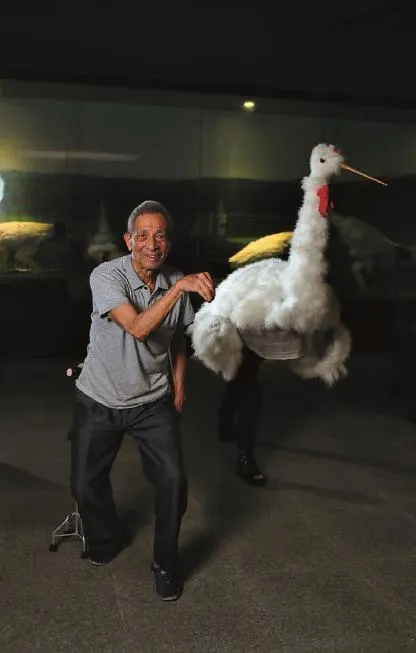
Chen FuyanInheritor of Sanzao Crane Dance, National Intangible CulturalHeritage陈福炎国家级非物质文化遗产“三灶鹤舞”传承人
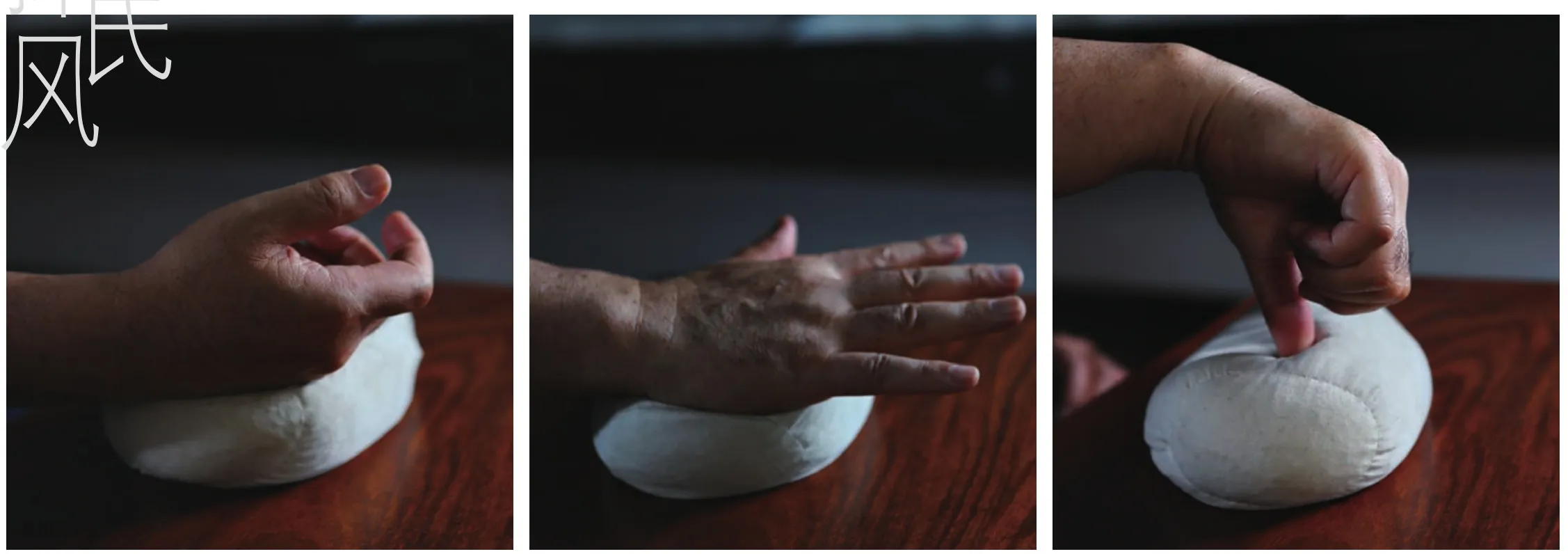
One-finger Zen message techniques: roll, rub, push, shake, stretch, pinch, etc.一指禅推拿手法:滚、揉、推、抖、拉、捻等。
Practice Medicine with Inner Power
One-fi nger Zen originates from Buddhism, passing down to the martial arts and Chinese medicine.
Han Jingshen with his martial arts background has practiced medicine in Zhuhai for two decades. Through therapeutic practices and internal refl ection, he inherited the One-Finger Zen Massage that had been passed down for 150 years. This therapeutic method takes the goal of “fi nding one's true self” in Zen Buddhism and takes Chinese medical theories as its foundation; it is often applied to solve muscle, spine and bone issues, such as knee degeneration and cervical vertebra injuries.
Han believes that kung fu is the basis of Chinese medicine. Learners have to capture the concept of life and anatomy through practices kung fu so as to exert their ability better in treating patients. Usual masseurs' strength is restricted to the hands but One-Finger Zen comes from the whole body. When the therapists transmit their strength, their bodies move naturally like swimming jellyfi sh. Any slight change will affect everything. This massage method supported by kung fu can relieve patients' pain at the time of massage. Han concluded a set of procedure on the basis of Yiquan and Chinese medicine exclusively for the learning of One-Finger Zen Massage. He promotes that learners will understand the movement of “chi”by cultivating their minds, spirits, and treatment skills, understand the diseases, and therapeutic principles through practicing.
Han Jingshen has personally trained almost 100 students. Besides specifi c technology and skill, One-Finger Zen Massage learners should practice Zen and learn how to diagnose with heart, sensing a patient's pain as if it is their own. A good message therapist can't merely pursue skills. They have to thoroughly understand the living body in order to discover the internal cause hidden in a patient's body, recognize big problems from small signs, and conduct treatments based on differentiation.
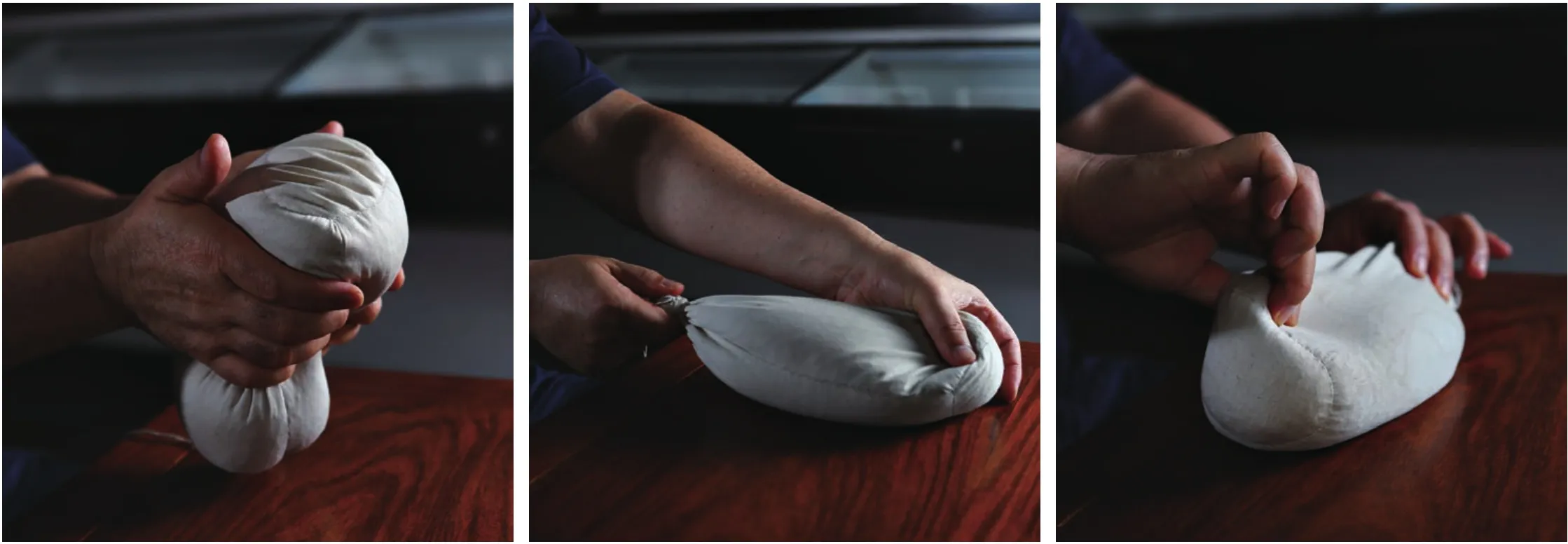
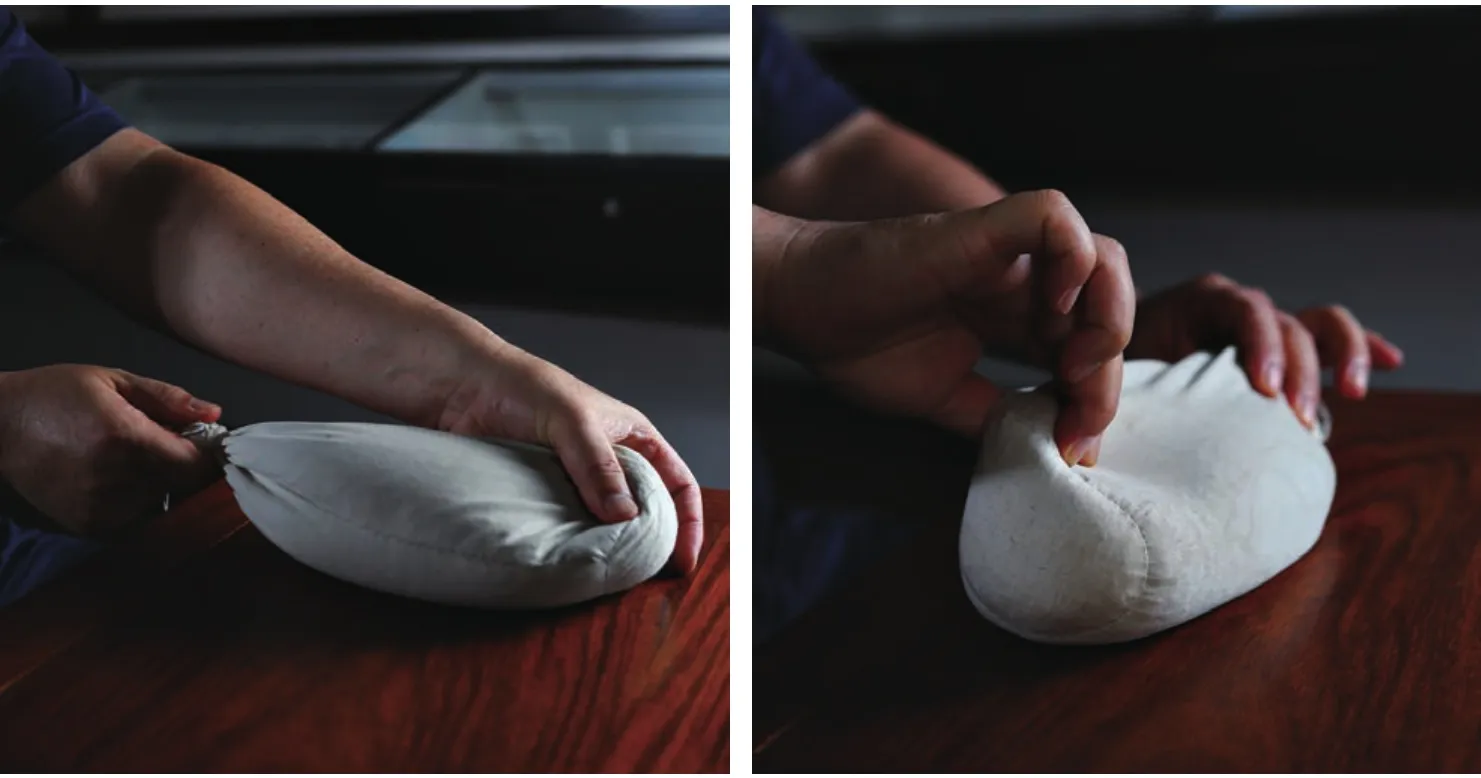
以道行医
“一指禅”来源于佛家智慧,一脉传入武术,一脉融入中医。
出身武门的韩竞生在珠海行医已三十余载。通过医疗实践和内观感悟,他继承了历经150年口传心授的“一指禅推拿疗法”。这套疗法以禅宗“明心见性”学说为宗旨,以中医理论为基础,常被用于解决筋骨问题,如膝关节退化、腰椎、颈椎病等。
韩竞生认为,练功是中医的基本功夫;推拿医生须练好推拿功法和疗法,在治疗时才能更好地发力。一般按摩师傅的发力点多局限于手部,而一指禅的发力点则在于全身,施力时,医者的形体仿如水母游泳般自然,牵一发而动全身。这种以功夫为支撑的推拿手法能够真正做到“手随心转,法从手出”。为此,韩竞生在“意拳”和中医导引学的基础上总结了一套功法,专门用于一指禅推拿的学习。他倡导习者通过“修心、修命、修技、修治”了解到“精、气、神”的运动,认识疾病,从而了解治疗的原则。
至今,韩竞生已亲手带出近百名徒弟。他认为,“一指禅推拿”的学习者必须修炼禅心,学会用心看病,由己及人地体察到病人的痛苦。一个好的推拿医生不能仅仅追求手法,只有对人体的活体生命有充分的感受和了解,在临症时才能做到“由表及里”,“见微知著”,“辨证论治”,在治疗操作时才能真正达到“法之所施,病人不知其苦”。
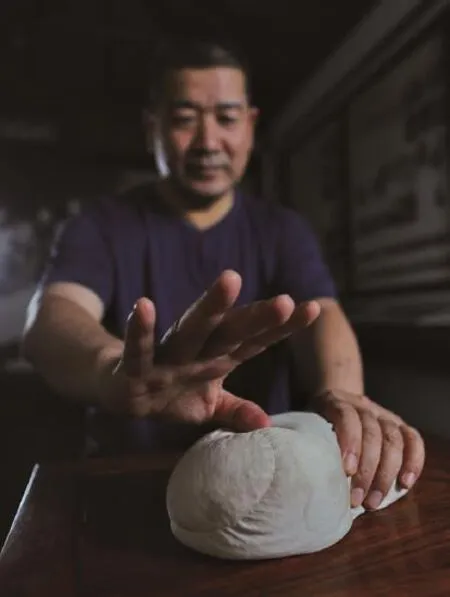
Han JingshenThe fifth-generation representative inheritor of One-Finger Zen Massage韩竞生一指禅推拿流派第五代代表性传承人
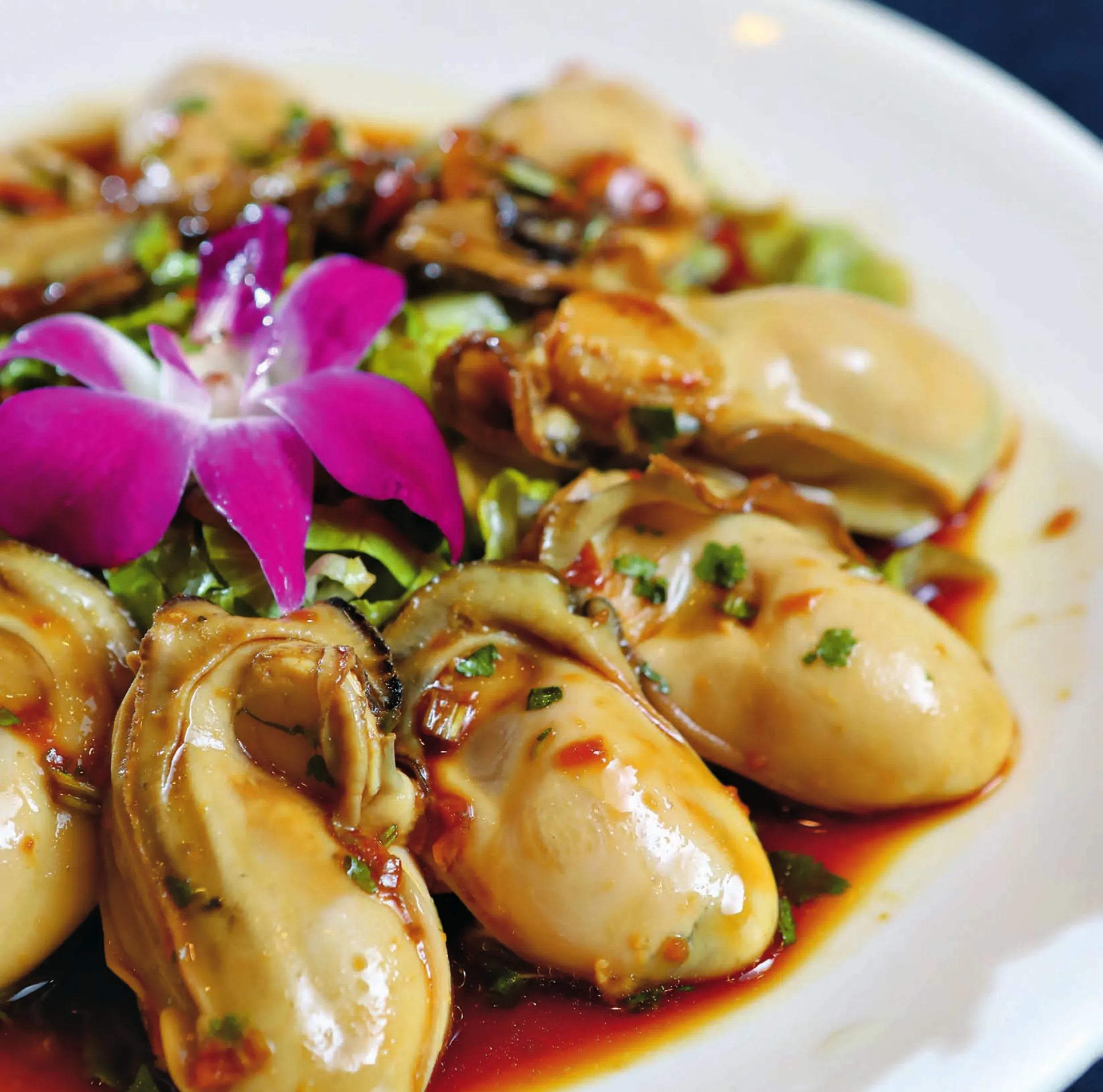
Jade and Pearl Oysters is an award-winning dish.获奖菜式“翡翠珍珠蚝”。
